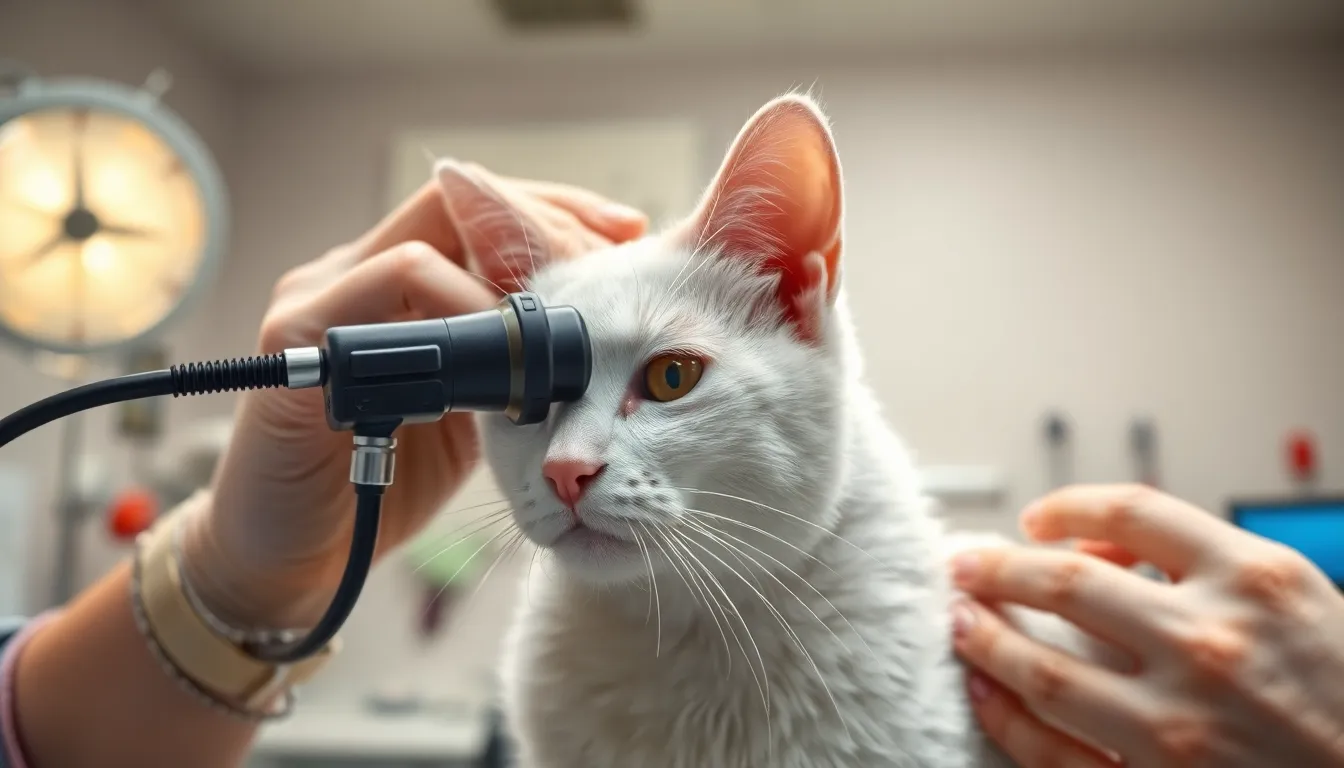Ear mites can be a pesky nuisance for cats, causing discomfort and irritation. These tiny parasites thrive in the warm, dark environment of a cat’s ears, leading to excessive scratching and potential infections. Understanding how to identify and treat ear mites is essential for any cat owner who wants to ensure their furry friend stays healthy and happy.
Effective treatment for ear mites involves a combination of veterinary care and at-home remedies. With the right approach, it’s possible to eliminate these unwelcome guests and restore your cat’s well-being. By recognizing the symptoms early and seeking appropriate treatment options, owners can help their cats find relief and prevent future infestations.
Table of Contents
ToggleUnderstanding Ear Mites in Cats
Ear mites are tiny parasites that infest the ear canals of cats, causing irritation and discomfort. They thrive in the warm, dark environment of the ears, leading to significant health issues if untreated.
What Are Ear Mites?
Ear mites, primarily Otodectes cynotis, are microscopic parasites affecting cats and other animals. They reproduce rapidly, with females laying up to 20 eggs daily. Ear mites feed on earwax and skin debris, leading to inflammation and discomfort. A common source of infestation includes contact with other infected animals, particularly in shelters or multi-pet households.
Symptoms of Ear Mite Infestation
- Excessive scratching: Cats often scratch or rub their ears to alleviate irritation.
- Dark, crumbly debris: A characteristic black or brownish discharge may be seen in the ear canal, resembling coffee grounds.
- Foul odor: An unpleasant smell can emanate from the infected ear due to secondary infections.
- Inflammation: Red, swollen ears indicate irritation or inflammation from the infestation.
- Behavioral changes: Increased agitation or discomfort can also signal an infestation.
Diagnosis of Ear Mites in Cats

Diagnosing ear mites in cats necessitates a thorough veterinary examination and specific diagnostic tests. Early detection streamlines treatment and minimizes discomfort for affected felines.
Veterinary Examination
Veterinary examination plays a crucial role in diagnosing ear mites. Vets assess the cat’s ears visually, looking for signs of irritation, redness, and debris. They also inquire about the cat’s behavior, specifically scratching and head shaking. If warranted, vets may use an otoscope to examine the ear canal more closely. This examination helps to differentiate between ear mites and other potential ear conditions, such as infections or allergies.
Diagnostic Tests
Diagnostic tests confirm the presence of ear mites. A vet may perform a cytology test, collecting ear debris and examining it under a microscope for the presence of mites or their eggs. In some cases, vets may recommend a thorough ear cleaning followed by a repeat examination. This process ensures accurate diagnosis and enables effective treatment planning, targeting the specific type of infestation present.
Ear Mites in Cats Treatment Options
Effective treatment for ear mites in cats involves various options that can be implemented at home or prescribed by a veterinarian. The choice of method depends on the severity of the infestation and the overall health of the cat.
Home Remedies
Home remedies can offer comfort to cats with mild ear mite infestations. Common options include:
- Olive oil: A few drops can help suffocate mites and soften ear debris.
- Vinegar solution: A mixture of equal parts water and white vinegar may assist in cleaning the ears, but it should not be used on open wounds.
- Garlic oil: Known for its natural anti-parasitic properties, garlic oil can be applied cautiously to the ears.
Consultation with a veterinarian before using home remedies ensures safety and effectiveness.
Veterinary Treatments
Veterinary treatments provide a comprehensive approach to eliminating ear mites. Veterinarians may recommend:
- Prescription medications: These might include topical acaricides specifically designed to target ear mites.
- Ear cleaning: Professional cleaning removes debris and facilitates better medication penetration.
Veterinary guidance guarantees proper treatment choices based on the cat’s condition.
Topical Medications
Topical medications dominate the most common treatment for ear mite infestations. These options include:
- Revolution: An effective topical solution that kills ear mites and other parasites.
- Selamectin: This widely used medication treats various external parasites, including ear mites.
Application of these medications typically requires direct contact with the affected area, ensuring prompt relief and eradication of mites.
Oral Medications
Oral medications serve as additional treatment options for more severe infestations. Typically considered:
- Ivermectin: Administered in a single dose, this medication effectively targets ear mites.
- Milbemycin oxime: This medication can also treat ear mites while addressing other parasitic infestations.
Veterinary consultation is essential to determine the appropriate dosage and avoid adverse effects.
Preventing Ear Mite Infestations
Preventing ear mite infestations in cats involves proactive measures that promote overall ear health. Consistent care and monitoring can significantly reduce the risk of these parasites.
Regular Ear Cleaning
Regular ear cleaning helps maintain a healthy ear environment and prevents debris buildup. Cat owners should clean their cat’s ears weekly using a veterinarian-recommended ear cleaner. Gentle application using a cotton ball or soft cloth ensures the removal of excess wax and dirt. Avoid using cotton swabs, as they can push debris further into the ear canal, potentially causing more harm than good.
Monitoring Cat Health
Monitoring cat health is crucial for early detection of any changes that may signal an infestation. Cat owners must observe their pets for signs of discomfort, including scratching, head shaking, or changes in behavior. Regular veterinary check-ups allow professionals to detect underlying issues and provide preventative care. Keeping cats away from potentially infected animals, especially in multi-pet households, minimizes the risk of transmission. Vaccination and parasite control, including routine flea and tick treatments, also contribute to overall well-being, further protecting against ear mite infestations.
Addressing ear mites in cats is essential for their comfort and health. Recognizing the symptoms early allows for timely intervention and effective treatment. A combination of veterinary care and at-home remedies can significantly alleviate the discomfort caused by these parasites.
Proactive measures like regular ear cleaning and monitoring can prevent future infestations. By staying vigilant and seeking professional guidance, cat owners can ensure their pets remain healthy and happy. Ultimately, understanding and managing ear mites is a crucial aspect of responsible pet ownership.





